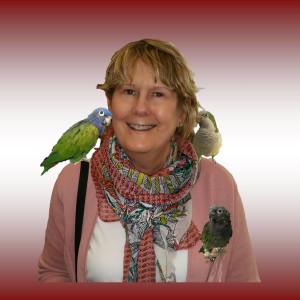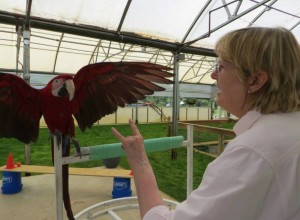SPOTLIGHT on a TRAINER – Patricia K Anderson, PhD.
 Patricia and I met at Ken Ramirez’s Professional Animal Trainers Workshop. She has an amazing knowledge set when it comes to anything bird and I’m happy to learn and share more about what brought Patricia to the positive reinforcement training world!
Patricia and I met at Ken Ramirez’s Professional Animal Trainers Workshop. She has an amazing knowledge set when it comes to anything bird and I’m happy to learn and share more about what brought Patricia to the positive reinforcement training world!
What was your route to positive reinforcement training?
It was a long journey. I have always had animals in my life and don’t feel complete without them. As a child I spent a lot of time on my grandparents’ farm watching wild and domestic animals. I also read everything in our local library about animals, including cross-cultural myths and legends about animals, thus foreshadowing my later interest in anthropology.
I have been fortunate to share my life with many wonderful animals, including a Shetland pony, horses, cats, guinea pigs, a gerbil, a mouse, a dog, a chinchilla, coatis, salamanders, fish, frogs, and today five parrots.
It was my first parrot that really prompted me to look more closely at what I was doing with this amazing, intelligent being. Otis, a pre-owned Quaker parrot, came to me with a lot of behavioral baggage including aggression and screaming. But his intelligence blew me away. I loved to sit and watch him figuring things out. I soon realized I knew nothing about birds. So I began reading. However, many of the books available then on pet parrots, contained information that seemed to be contradictory. For example, a common bit of advice was to force your bird to “ladder” from one hand to the next if he bites you. Also, to “adjust the bird’s attitude,” you were supposed to trim their wings. From my observation of Otis, he seemed to be fearful of people, hence the aggression and frustration. Forcing your bird, in my mind, would likely cause more fear and aggression. Trimming wings takes away choices. Parrots are adapted for flight. It was not until much later that I found that I was right. It took me about a year to gain Otis’ trust. He was an amazing bird and the reason that I eventually began my studies into the human-avian bond and behavior science. Sadly, Otis died prematurely from hemochromatosis. I still miss him.
I was so fascinated by Otis, that it prompted me to add a new specialty to my research and teaching. Anthrozoology, the interdisciplinary study of human-animal interactions, is a relatively new field, which was founded at the University of Cambridge, UK, about 30 years ago. During my early tenure at Western Illinois University I developed an Anthrozoology, course that I teach each spring to interested undergrads and grad students in the WIU Zoo & Aquarium Studies program. My course considers how culture affects the way we see other species and their world. Since I have begun studying behavior science and training, I have added these to the course.
I was on sabbatical from my university during the fall term of 2010 and decided to enroll in Dr. Susan Friedman’s telecourse, Living and Learning with Animals for Animal Professionals. It was a rigorous 8-week course with class attendance and graded homework. What I learned was a major paradigm shift for me! We watched a video of a lion in a zoo, who voluntarily put their hip against an enclosure wall when cued so that the veterinarian could inoculate him without any restraint! The entire course included examples of multiple species voluntarily participating in husbandry, veterinary and other training behaviors, free of physical or chemical coercion. Incredible stuff! I thought to myself, this is the way we should interact with all animals and people. Based on what I learned in Dr. Friedman’s course, I immediately began applying these principles to my birds, and soon made my first YouTube video showing my Pionus parrots recalling. When I watch it today, I cringe at my language, but the positive relationship that I had built with those birds through positive reinforcement is clear. That makes me happy.
After Dr. Friedman’s telecourse I went on to participate in hands on training workshops at Natural Encounters, Inc. with Steve Martin and Dr. Friedman. I completed both the course for animal professionals and later the companion parrot course. I have also completed training courses with Lara Joseph, Barbara Heidenreich, Sid Price and Robin Shewokis, and Ken Ramirez. I love to attend workshops with other animal professionals and continue to learn and grow.

Were you always interested in science or did behavioral science pique your interest at a later time and how?
I have always love biology and zoology and the sciences. However, I majored in Anthropology as an undergraduate with an interest in archaeology. I minored in Psychology. Later I went on to earn my PhD in Anthropology from the University of Chicago. However, I didn’t begin studying Applied Behavior Analysis until fall of 2010, as I described above.
Are there specific skill sets from previous career paths which have aided you in your current role?
In anthropology we are trained to be open minded and objective and sensitive cross-culturally to other beliefs. I think anthropology made me think more critically about human-animal relationships and how many people through time and space have embraced animal companions as fictive kin. Historically, anthropology has been anthropocentric or human-centered, but in Anthrozoology we attempt to consider how these relationships also potentially impact animals. As an anthropologist I am interested in how we view animals and the natural world through a cultural lens. Even though we may be scientists, we grow up in a social context that is affected by gender, age, religion, ethnicity, socioeconomic status, education, experience and other individual and cultural factors.
As a trainer, I am both fascinated and troubled by the perception by many that dominance and coercion are the norm. It is difficult to fight against—we see it in the old argument of whether or not corporal punishment is appropriate for children. Despite the evidence today that the side effects from spanking are similar to those sustained by abuse victims, I hear so many people claiming it didn’t harm them and defending their parents and their actions with their own children. I think it likely that is an artifact of the continuing patriarchal social structure of inequality that permeates Western society. It is so entrenched and normalized that many don’t question it.
What is one piece of advice from someone that you consider a “mentor” that you’d like to share?
That is such a tough one. I am honored to have studied and learned from some well-known individuals, including Dr. Susan Friedman, Ken Ramirez, Sid Price and others. I think that the simple mantra, “set yourself and your animal up for success” is one of the most important lessons I have learned from Dr. Friedman. It made me reevaluate my entire life, and allowed me to see I had options that were unclear to me previously. I am happier and healthier and a better teacher with both my students and birds today because of it. Steve Martin’s advice to build a trust account with your animals, and continue to pay into it because someday, perhaps during a veterinary visit for example, you will have to make a withdrawal, is also very important. However, if your trust account is healthy, your relationship will remain undamaged. In addition, Steve tells us to focus on the positive. Instead of telling people everything is doom and gloom, give them options on how they can make a difference. Empower your learners! And Ken Ramirez so impressed me with everything he does, but the thing that I really liked was his professionalism with those who use aversive methods with their animals. To Ken, it seems, the door is always open for communication; he just might change their minds in the future. And of course, it was in Ken’s class at the Shedd Aquarium that I met you, Terrie! What an amazing experience, all around.
What is your favorite part of your day?
Working with my five parrots. Seeing how excited and eager they are to see me each day and to learn new behaviors. When I’m in the classroom teaching I also look forward to seeing my students and sharing with them. I love teaching.
What do you find to be the most challenging in working with people and animals?
The people by far are the most challenging, because they tend to have so many preconceptions about animals, behavior, and training. Animals are far less complicated. That does not mean that they are not intelligent, but rather that they are not hindered by misconceptions inspired by anthropomorphism and other ideologies.
I sometimes hear students tell me that they only like animals. And then I tell them, that if they want to work with animals they had better learn to like and communicate with humans too, because people, in the form of owners, agencies or governments control animals. And of course, scientifically humans are animals too!
What are some key skills required for animal training?
Keen observation skills are essential. I always thought I was a good observer until I studied behavior science and I was floored to realize that I was missing so much. The knowledge of and ability to read the body language that is unique to each species and to individual animals. Being curious, inquisitive and motivated to learn. You also have to really love what you do, and consider working with animals a privilege. And always be a professional.
What a pleasure it was to learn more about my friend and colleague Patricia! Patricia, thank you so much for taking the time to share more about your training journey! If you would like to learn more about Patricia you can connect with her at her Youtube Channel: PK Anderson Human Avian Bond: https://www.youtube.com/channel/UCzvgilPvymFVZSH8IOxRwSQ
Note: For anyone out there who is looking to become a certified, professional, positive trainer, come and join me in Miami! Applications being accepted now: https://www.karenpryoracademy.com/dog-trainer-professional/national/miami-fl
